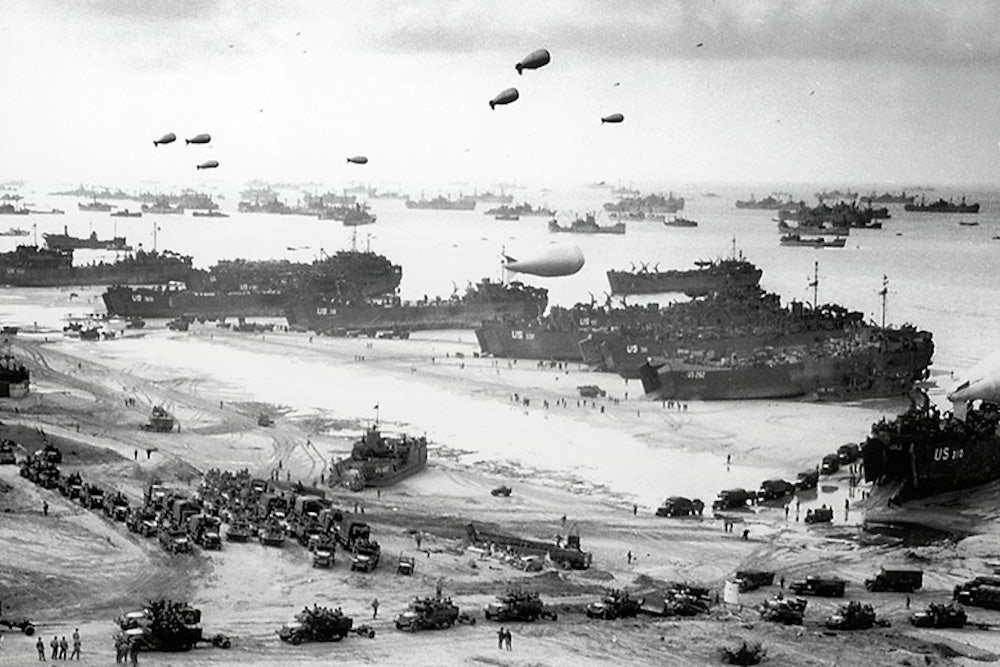At 12:15 a.m. on June 6, 1944, the Allied forces stormed the beaches of Normandy, marking the beginning of the D-Day invasion and the quest to liberate mainland Europe from Nazi occupation. Code-named Operation Neptune, it was the largest amphibious invasion in history. Braving strong winds and choppy waters, more than 156,000 American, Canadian, and British troops landed on five beaches of the heavily guarded northern coast of France. Many have said the D-Day landings marked the beginning of the end of World War II.
70 years after the D-Day landings, Scottish photographer Peter MacDiarmid revisited some of the key locations from that day. He juxtaposed iconic images from the past with scenes from Normandy today.
 Peter Macdiarmid/Getty Images and Frank Scherschel/Time & Life Pictures/Getty Images
Peter Macdiarmid/Getty Images and Frank Scherschel/Time & Life Pictures/Getty Images
A view of a town square, stockpiled with supplies and ammunition earmarked for the impending D-Day invasion of France, Moreton-in-Marsh, England, May 1944. The same area was photographed on May 12, 2014 to create the composite.
 Peter Macdiarmid/Getty Images and Galerie Bilderwelt/Getty Images
Peter Macdiarmid/Getty Images and Galerie Bilderwelt/Getty Images
U.S. troops on the Esplanade at Weymouth, Dorset, on their way to embark on ships bound for Normandy’s Omaha Beach. The present day view was taken on April 5, 2014
.  Peter Macdiarmid/Getty Images and Capt. J L Evans/IWM via Getty Images
Peter Macdiarmid/Getty Images and Capt. J L Evans/IWM via Getty Images
British Commandos of the First Special Service Brigade are shown landing on “Queen Red” Beach in La Breche, France, at about 8:40 on the morning of June 6, 1944. La Breche’s present-day seafront was taken on May 8, 2014.
 Peter Macdiarmid/Getty Images and Lt. Handford/IWM via Getty Images
Peter Macdiarmid/Getty Images and Lt. Handford/IWM via Getty Images
British Royal Marine Commandos of the Fourth Special Service Brigade scramble to shore from their landing craft on “Nan Red” Beach at St. Aubin-sur-Mer at about 9 a.m. on June 6, 1944. The same area was photographed on May 6, 2014 to create the composite.
 Peter Macdiarmid/Getty Images and Galerie Bilderwelt/Getty Images
Peter Macdiarmid/Getty Images and Galerie Bilderwelt/Getty Images
German prisoners are gathered and an American flag is deployed for signaling at the cliffs of Pointe du Hoc, where Colonel James E. Rudder established a command post, June 1944. The present-day scene with a view of the cliffs was taken on May 6, 2014.
 Peter Macdiarmid/Getty Images and Galerie Bilderwelt/Getty Images
Peter Macdiarmid/Getty Images and Galerie Bilderwelt/Getty Images
Canadian troops landing at Juno Beach on the outskirts of Bernieres-sur-Mer on D-Day. 14,000 Canadian soldiers were put ashore and 340 lost their lives in the battles for the beachhead. The present-day view was taken on May 5, 2014.
 Peter Macdiarmid/Getty Images and Popperfoto/Getty Images
Peter Macdiarmid/Getty Images and Popperfoto/Getty Images
American craft of all styles pictured at Omaha Beach in Normandy, near Colleville-sur-Mer, during the first stages of the Allied invasion. The beach’s present day seafront was taken on May 7, 2014.
 Peter Macdiarmid/Getty Images and Popperfoto/Getty Images
Peter Macdiarmid/Getty Images and Popperfoto/Getty Images
A French armored column passing through the small French town of St. Mere Eglise on D-Day gets a warm welcome from the inhabitants. Present day facades frame the same scene in a May 7, 2014 photo.
 Peter Macdiarmid/Getty Images and Galerie Bilderwelt/Getty Images
Peter Macdiarmid/Getty Images and Galerie Bilderwelt/Getty Images
A group of American soldiers stand at the village fountain on June 12, 1944. A woman carries pitchers while children watch the scene. The village of Saint-Marie-du-Mont was liberated by a group of paratroopers of the 501st and 506th Regiments of the 101st Airborne Division. The view of the village today was taken May 7, 2014.
 Peter Macdiarmid/Getty Images and Galerie Bilderwelt/Getty Images
Peter Macdiarmid/Getty Images and Galerie Bilderwelt/Getty Images
Soldiers of the Royal Canadian Army Medical Corps place flowers on temporary graves for a Scottish, a Canadian, and two French civilians, in June 1944. Two soldiers wear the armband for the Red Cross. In the background, we can see a view of the graveyard with the church of Saint Georges de Basly on May 5, 2014.
